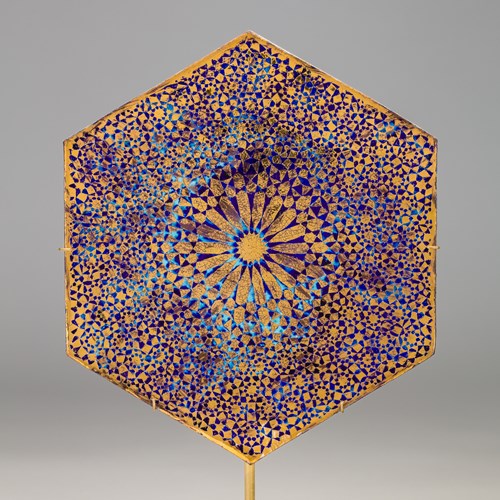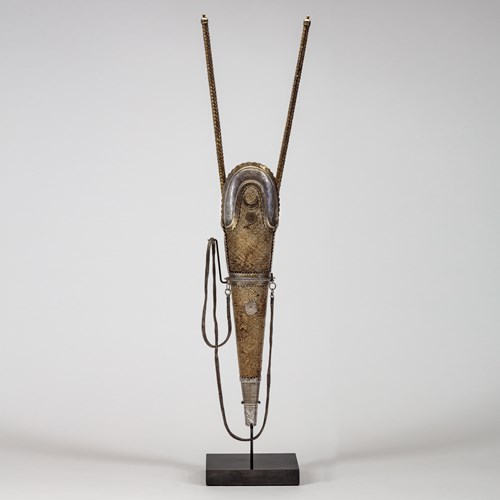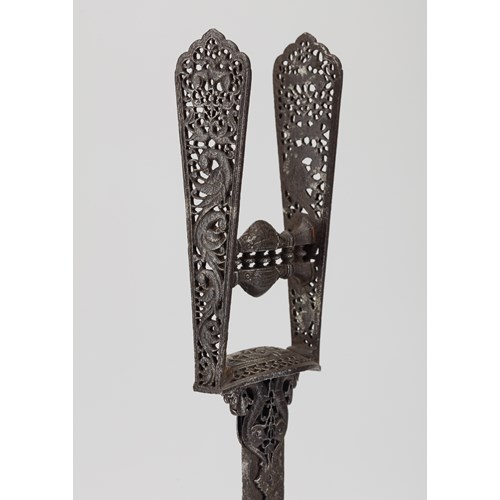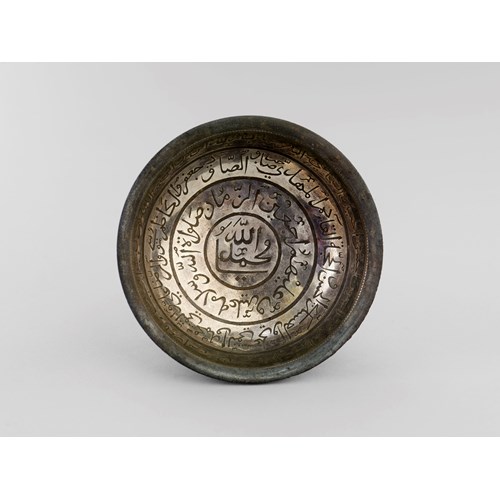Marketplace
Bidri Huqqa Base
Bidri Huqqa Base
Date 17th century
Epoque 1600-1750, 17th century
Origine India, Deccan, Bidar
Medium Zinc alloy; cast, engraved, inlaid with brass and silver
Dimension 19.5 cm (7⁵/₈ inches)
The metal huqqa base is of a globular form and rises from a short foot to a spherical body. It tapers towards the neck, which features a disc-like ring, adorned with brass and silver inlay. The meandering pattern is depicted with alternating plants, foliage, flowers and distinctive cypress trees.
The arrival of tobacco in India in the sixteenth-century provided local craftsmen with a new regime of metal work and design. Artists hailing from areas such as Bidar, in southern India, were needed to create huqqa bases in order to meet the new demand and fashion for smoking tobacco. By the seventeenth century, smoking had become a common pastime of pre-modern Indian society and across all social strata. This huqqa base would have originally been fitted with a long, thin stem and pipe through which the smoker could easily inhale. Deccan in particular became a prominent centre of production for the huqqa base in the seventeenth and eighteenth centuries. The area was also known for the style and decoration of its inlay; known as ‘bidri’. Artists darkened the base metal of their works in order to highlight the inlaid metal decoration of their objects. This created an alluring contrast and culminated in the widespread popularity of the bidri wares.
The form of our huqqa base is characteristic of seventeenth-century Deccani examples. For instance, The Metropolitan Museum of Art, New York, contains within its collections one such bidri ware, which is of a nearly identical form to our piece, and features similar alternating inlaid leaf-pattern in brass and silver, around the rim of its tapered neck, Accession Number 1984.221. This shape and style of huqqa is also depicted in Indian painting of the same period. The Indian Museum in Calcutta contains an illustration of a Nawab smoking a huqqa, in a vibrant palette, which appears related in size and form to our huqqa, while it also conveys how one would have used such an object (Cited in, M. Zebrowski, Gold, Silver and Bronze from Mughal India, 1997, Fig. 363, p. 226). Numerous private collections contain examples of seventeenth-century Deccani huqqa wares. Several notable works are reprinted in Mark Zebrowski’s book, Gold, Silver and Bronze from Mughal India, London, 1997. They depict nearly identical inlaid decoration, arranged in visibly related floral designs – with the same style of leaves – as our huqqa (Zebrowski, Gold, Silver and Bronze from Mughal India, Figs. 376 and 381, pp. 231-232). These floral spray motifs are also found in wider Mughal art of the period, notably in manuscript and album painting, thus suggesting they were perhaps made to appeal to the Mughal or Indian market of the day (Zebrowski, Gold, Silver and Bronze from Mughal India, p. 232). The cypress trees that adorn our object also comprise a popular motif in seventeenth-century Mughal art and luxury goods. For example, The Victoria and Albert Museum, London, houses a magnificent seventeenth-century Mughal cabinet made for the European market, attributed to Gujarat or Sind, with inlaid ivory figural decoration, Accession Number: LOAN:POTELIAKHOFF 1 to 27. On the interior of each of the cabinet doors two-cypress trees flank a Mughal officer or court attendant. They appear stylistically related to the cypress trees that embellish our huqqa base.
Condition report: Areas of damage to the body with museum restoration
Literature: Zebrowski, M. Gold, Silver & Bronze from Mughal India, Alexandria Press in association with Laurence King, London, 1997.
Stock no.: A4651
The arrival of tobacco in India in the sixteenth-century provided local craftsmen with a new regime of metal work and design. Artists hailing from areas such as Bidar, in southern India, were needed to create huqqa bases in order to meet the new demand and fashion for smoking tobacco. By the seventeenth century, smoking had become a common pastime of pre-modern Indian society and across all social strata. This huqqa base would have originally been fitted with a long, thin stem and pipe through which the smoker could easily inhale. Deccan in particular became a prominent centre of production for the huqqa base in the seventeenth and eighteenth centuries. The area was also known for the style and decoration of its inlay; known as ‘bidri’. Artists darkened the base metal of their works in order to highlight the inlaid metal decoration of their objects. This created an alluring contrast and culminated in the widespread popularity of the bidri wares.
The form of our huqqa base is characteristic of seventeenth-century Deccani examples. For instance, The Metropolitan Museum of Art, New York, contains within its collections one such bidri ware, which is of a nearly identical form to our piece, and features similar alternating inlaid leaf-pattern in brass and silver, around the rim of its tapered neck, Accession Number 1984.221. This shape and style of huqqa is also depicted in Indian painting of the same period. The Indian Museum in Calcutta contains an illustration of a Nawab smoking a huqqa, in a vibrant palette, which appears related in size and form to our huqqa, while it also conveys how one would have used such an object (Cited in, M. Zebrowski, Gold, Silver and Bronze from Mughal India, 1997, Fig. 363, p. 226). Numerous private collections contain examples of seventeenth-century Deccani huqqa wares. Several notable works are reprinted in Mark Zebrowski’s book, Gold, Silver and Bronze from Mughal India, London, 1997. They depict nearly identical inlaid decoration, arranged in visibly related floral designs – with the same style of leaves – as our huqqa (Zebrowski, Gold, Silver and Bronze from Mughal India, Figs. 376 and 381, pp. 231-232). These floral spray motifs are also found in wider Mughal art of the period, notably in manuscript and album painting, thus suggesting they were perhaps made to appeal to the Mughal or Indian market of the day (Zebrowski, Gold, Silver and Bronze from Mughal India, p. 232). The cypress trees that adorn our object also comprise a popular motif in seventeenth-century Mughal art and luxury goods. For example, The Victoria and Albert Museum, London, houses a magnificent seventeenth-century Mughal cabinet made for the European market, attributed to Gujarat or Sind, with inlaid ivory figural decoration, Accession Number: LOAN:POTELIAKHOFF 1 to 27. On the interior of each of the cabinet doors two-cypress trees flank a Mughal officer or court attendant. They appear stylistically related to the cypress trees that embellish our huqqa base.
Condition report: Areas of damage to the body with museum restoration
Literature: Zebrowski, M. Gold, Silver & Bronze from Mughal India, Alexandria Press in association with Laurence King, London, 1997.
Stock no.: A4651
Date: 17th century
Epoque: 1600-1750, 17th century
Origine: India, Deccan, Bidar
Medium: Zinc alloy; cast, engraved, inlaid with brass and silver
Dimension: 19.5 cm (7⁵/₈ inches)
Literature: Zebrowski, M. Gold, Silver & Bronze from Mughal India, Alexandria Press in association with Laurence King, London, 1997.
Plus d'œuvres d'art de la Galerie









